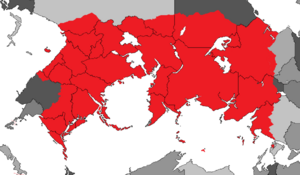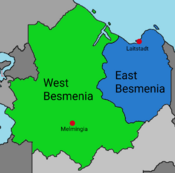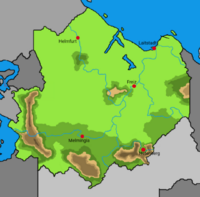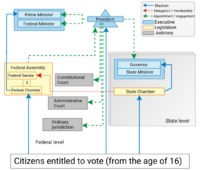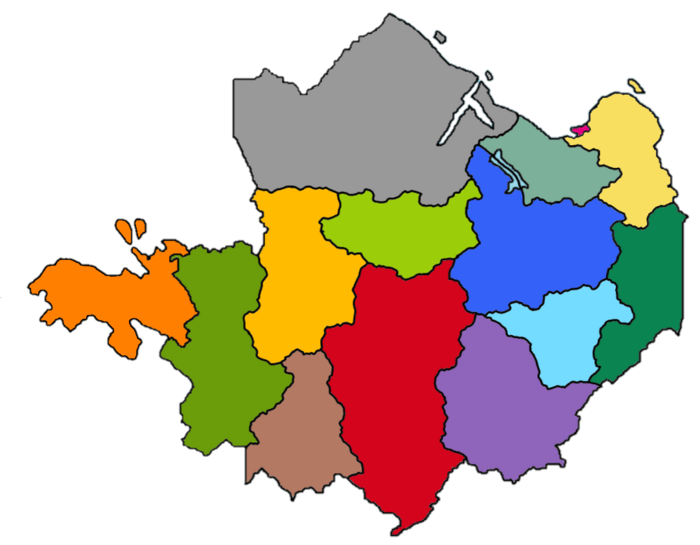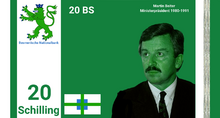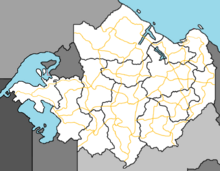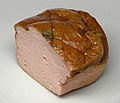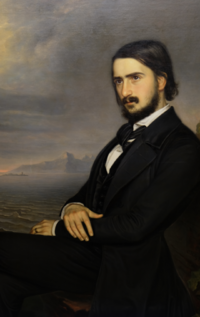Besmenia: Difference between revisions
Neuleinster (talk | contribs) No edit summary |
Neuleinster (talk | contribs) No edit summary |
||
| (274 intermediate revisions by 8 users not shown) | |||
| Line 1: | Line 1: | ||
{{Infobox country | {{Infobox country | ||
|micronation = <!--yes if a micronation--> | |micronation = <!--yes if a micronation--> | ||
| Line 13: | Line 12: | ||
|alt_flag2 = <!--alt text for second flag--> | |alt_flag2 = <!--alt text for second flag--> | ||
|flag2_border = <!--set to no to disable border around the flag--> | |flag2_border = <!--set to no to disable border around the flag--> | ||
|image_coat = | |image_coat = Old Besmenian coat of arm.png | ||
|alt_coat = <!--alt text for coat of arms--> | |alt_coat = <!--alt text for coat of arms--> | ||
|symbol_type = <!--emblem, seal, etc (if not a coat of arms)--> | |symbol_type = <!--emblem, seal, etc (if not a coat of arms)--> | ||
| Line 24: | Line 23: | ||
|other_symbol_type = <!--Use if a further symbol exists, e.g. hymn--> | |other_symbol_type = <!--Use if a further symbol exists, e.g. hymn--> | ||
|other_symbol = | |other_symbol = | ||
|image_map =[[File: | |image_map =[[File:New Besmenian Map4.png|200px]] <!--e.g. LocationCountry.svg--> | ||
|loctext = <!--text description of location of country--> | |loctext = <!--text description of location of country--> | ||
|alt_map = <!--alt text for map--> | |alt_map = <!--alt text for map--> | ||
| Line 31: | Line 30: | ||
|alt_map2 = <!--alt text for second map--> | |alt_map2 = <!--alt text for second map--> | ||
|map_caption2 = <!--Caption to place below second map--> | |map_caption2 = <!--Caption to place below second map--> | ||
|capital = [[ | |capital = [[Laitstadt]] <!--Name of country/territory's capital, wikilinked if link exists--> | ||
|coordinates = <!-- Coordinates for capital, using {{tl|coord}} --> | |coordinates = <!-- Coordinates for capital, using {{tl|coord}} --> | ||
|largest_city = | |largest_city = Laitstadt <!--Name of country/territory's largest city. Use "capital" (without quotation marks) if it's the capital.--> | ||
|largest_settlement_type = <!--Type of settlement if largest settlement not a city--> | |largest_settlement_type = <!--Type of settlement if largest settlement not a city--> | ||
|largest_settlement = <!--Name of largest settlement--> | |largest_settlement = <!--Name of largest settlement--> | ||
|official_languages = {{wp|Standard German|Besmenian}} | |official_languages = {{wp|Standard German|Besmenian}} | ||
<!--Languages recognised in legislation, constitution, etc--> | |||
|national_languages = <!--Country/territory-wide languages recognised but not necessarily in country/territory-wide law, etc--> | |national_languages = <!--Country/territory-wide languages recognised but not necessarily in country/territory-wide law, etc--> | ||
|regional_languages = [[ | |regional_languages = [[wikipedia: Greek language|Utobanian]] <!--Languages recognised or associated with particular regions within the country/territory--> | ||
|languages_type = <!--Use to specify a further type of language, if not official, national or regional--> | |languages_type = <!--Use to specify a further type of language, if not official, national or regional--> | ||
|languages = <!--Languages of the further type--> | |languages = <!--Languages of the further type--> | ||
| Line 46: | Line 45: | ||
|languages2 = <!--Languages of this second further type--> | |languages2 = <!--Languages of this second further type--> | ||
|languages2_sub = <!--Is the second alternative type of languages a sub-item of the previous non-sub type? ("yes" or "no")--> | |languages2_sub = <!--Is the second alternative type of languages a sub-item of the previous non-sub type? ("yes" or "no")--> | ||
|ethnic_groups = | |ethnic_groups = Besmenians: 89%<br/>Others: 11% <!--List/breakdown of ethnic groups within the country/territory--> | ||
|ethnic_groups_year = 2021<!--Year of ethnic groups data (if provided)--> | |||
|ethnic_groups_year = | |||
|ethnic_groups_ref = <!--(for any ref/s to associate with ethnic groups data)--> | |ethnic_groups_ref = <!--(for any ref/s to associate with ethnic groups data)--> | ||
|religion = | |religion = [[Besmenian orthodoxy]]: 52.5%<br/>Atheism: 30.4%<br/>Catholic: 10.4%<br/>Islam: 2.7%<br/>Buddhism: 1.8%<br/>Others: 2.2%<!--Religion--> | ||
|religion_year = <!--Year of religion data (if provided)--> | |||
|religion_year = | |||
|religion_ref = <!--(for any ref/s to associate with religion data)--> | |religion_ref = <!--(for any ref/s to associate with religion data)--> | ||
|demonym = Besmenian <!--Term/s describing those associated with the country/territory (e.g. "Belgian" for the country Belgium)--> | |demonym = Besmenian <!--Term/s describing those associated with the country/territory (e.g. "Belgian" for the country Belgium)--> | ||
|government_type = {{wp|Federalism|Federal}} {{wp|parliamentary }} {{wp|republic}} <!--(often a compound multi-wikilinked term, e.g. "Federal semi-presidential constitutional republic", etc)--> | |government_type = {{wp|Federalism|Federal}} {{wp|parliamentary }} constitutional {{wp|republic}} <!--(often a compound multi-wikilinked term, e.g. "Federal semi-presidential constitutional republic", etc)--> | ||
|leader_title1 =President <!--(for a country, usually the head of state's (wikilinked) title, e.g. "President", "Monarch")--> | |leader_title1 =[[President of Besmenia|President]] <!--(for a country, usually the head of state's (wikilinked) title, e.g. "President", "Monarch")--> | ||
|leader_name1 = | |leader_name1 = [[Erika Badt-Springer]] | ||
|leader_title2 = Prime Minister <!--(could be "Vice President", otherwise "Prime Minster", etc, etc)--> | |leader_title2 = [[Prime Minister of Besmenia|Prime Minister]] <!--(could be "Vice President", otherwise "Prime Minster", etc, etc)--> | ||
|leader_name2 = | |leader_name2 = [[Thomas Pühringer]] | ||
|leader_title3 = [[President of the Federal Chamber]] <!--(up to 14 distinct leaders may be included)--> | |||
|leader_name3 = Barbara Schröder | |||
<!--......--> | <!--......--> | ||
|legislature = <!--Name of the country/territory's governing body, e.g. "Parliament", "Congress", etc--> | |legislature = <!--Name of the country/territory's governing body, e.g. "Parliament", "Congress", etc--> | ||
|upper_house = | |upper_house = [[Federal Senate (Besmenia)|Federal Senate]] <!--Name of governing body's upper house, if given (e.g. "Senate")--> | ||
|lower_house = [[ | |lower_house = [[Federal Chamber (Besmenia)|Federal Chamber]] <!--Name of governing body's lower house, if given (e.g. "Chamber of Deputies")--> | ||
|sovereignty_type = <!--Brief description of country/territory's status ("Independence [from...]", "Autonomous province [of...]", etc)--> | |sovereignty_type = <!--Brief description of country/territory's status ("Independence [from...]", "Autonomous province [of...]", etc)--> | ||
|sovereignty_note = | |sovereignty_note = | ||
|established_event1 = [[Basic Law of | |established_event1 = [[Basic Law of Besmenia|Basic law adopted]] <!--First key event in history of country/territory's status or formation--> | ||
|established_date1 = July 2, 1920 <!--Date of first key event--> | |established_date1 = July 2, 1920 <!--Date of first key event--> | ||
|established_event2 = Reunification<!--Second key event--> | |established_event2 = Reunification<!--Second key event--> | ||
|established_date2 = September 14, | |established_date2 = September 14, 1967 <!--Date of second key event--> | ||
|established_event3 = Addmited to the CCA<!--Second key event--> | |||
|established_date3 = December 15, 1982 | |||
<!--......--> | <!--......--> | ||
|established_event13 = <!--(up to 13 distinct events may be included)--> | |established_event13 = <!--(up to 13 distinct events may be included)--> | ||
|established_date13 = | |established_date13 = | ||
|area_rank = | |area_rank = | ||
|area = | |area = <!--Major area size (in [[Template:convert]] either km2 or sqmi first)--> | ||
|area_km2 = | |area_km2 = 3,287,263 <!--Major area size (in square km)--> | ||
|area_sq_mi = <!--Area in square mi (requires area_km2)--> | |area_sq_mi = <!--Area in square mi (requires area_km2)--> | ||
|area_footnote = <!--Optional footnote for area--> | |area_footnote = <!--Optional footnote for area--> | ||
| Line 87: | Line 83: | ||
|area_label2 = <!--Label below area_label (optional)--> | |area_label2 = <!--Label below area_label (optional)--> | ||
|area_data2 = <!--Text after area_label2 (optional)--> | |area_data2 = <!--Text after area_label2 (optional)--> | ||
|population_estimate = | |population_estimate = 78,816,711 | ||
|population_estimate_rank = | |population_estimate_rank = | ||
|population_estimate_year = | |population_estimate_year = 2022 | ||
|population_census = | |population_census = | ||
|population_census_year = | |population_census_year = | ||
|population_density_km2 = | |population_density_km2 = 22 | ||
|population_density_sq_mi = | |population_density_sq_mi = | ||
|population_density_rank = | |population_density_rank = | ||
|nummembers = <!--An alternative to population for micronation--> | |nummembers = <!--An alternative to population for micronation--> | ||
|GDP_PPP = $ | |GDP_PPP = $5,920 trillion <!--(Gross Domestic Product from Purchasing Power Parity)--> | ||
|GDP_PPP_rank = | |GDP_PPP_rank = | ||
|GDP_PPP_year = | |GDP_PPP_year = 2021 | ||
|GDP_PPP_per_capita = $ | |GDP_PPP_per_capita = $60,425 | ||
|GDP_PPP_per_capita_rank = | |GDP_PPP_per_capita_rank = | ||
|GDP_nominal = $ | |GDP_nominal = $5,35 trillion | ||
|GDP_nominal_rank = | |GDP_nominal_rank = | ||
|GDP_nominal_year = | |GDP_nominal_year = 2022 | ||
|GDP_nominal_per_capita = $ | |GDP_nominal_per_capita = $49,835 | ||
|GDP_nominal_per_capita_rank = | |GDP_nominal_per_capita_rank = | ||
|Gini = <!--(Gini measure of income inequality; input number only; valid values are between 0 and 100)--> | |Gini = <!--(Gini measure of income inequality; input number only; valid values are between 0 and 100)--> | ||
| Line 116: | Line 111: | ||
|HDI_rank = | |HDI_rank = | ||
|HDI_ref = <!--(for any ref/s to associate with HDI number)--> | |HDI_ref = <!--(for any ref/s to associate with HDI number)--> | ||
|currency = [[Besmenian | |currency = [[Besmenian schilling]] <!--Name/s of currency/ies used in country/territory--> | ||
|currency_code = BS <!--ISO 4217 code/s for currency/ies (each usually three capital letters)--> | |currency_code = BS <!--ISO 4217 code/s for currency/ies (each usually three capital letters)--> | ||
|time_zone = <!--e.g. GMT, PST, AST, etc, etc (wikilinked if possible)--> | |time_zone = <!--e.g. GMT, PST, AST, etc, etc (wikilinked if possible)--> | ||
| Line 124: | Line 119: | ||
|DST_note = <!--Optional note regarding DST use--> | |DST_note = <!--Optional note regarding DST use--> | ||
|antipodes = <!--Place/s exactly on the opposite side of the world to country/territory--> | |antipodes = <!--Place/s exactly on the opposite side of the world to country/territory--> | ||
|date_format = | |date_format = dd,mm,yyyy <!--all-numeric date format and era, such as [[Common Era|CE]], [[Anno Domini|AD]], [[Hijri year|AH]], etc.; e.g. {{abbr|yyyy|year}}-{{abbr|mm|month}}-{{abbr|dd|day}} ([[Anno Domini|AD]]) --> | ||
|electricity = <!--e.g. "230 V–50 Hz"--> | |electricity = <!--e.g. "230 V–50 Hz"--> | ||
|drives_on = right <!--"right" or "left" (side of road)--> | |drives_on = right <!--"right" or "left" (side of road)--> | ||
|cctld = .bm <!--Internet country code top-level domain identifier (e.g. [[.br]], [[.de]], etc) | |cctld = [[.bm]] <!--Internet country code top-level domain identifier (e.g. [[.br]], [[.de]], etc) | ||
|iso3166code = <!--Use to override default from common_name parameter above; omit using "omit".--> | |iso3166code = <!--Use to override default from common_name parameter above; omit using "omit".--> | ||
|calling_code = + | |calling_code = +10 <!--e.g. [[+1]], [[+531]], [[+44]], etc--> | ||
|patron_saint = <!--Use patron_saints for multiple--> | |patron_saint = <!--Use patron_saints for multiple--> | ||
|image_map3 = <!--Optional third map position, e.g. for use with reference to footnotes below it--> | |image_map3 = <!--Optional third map position, e.g. for use with reference to footnotes below it--> | ||
| Line 140: | Line 135: | ||
}} | }} | ||
The '''Federal Republic of Besmenia''', commonly called '''Besmenia''', is a {{wp|German-speaking}} country [[ | The '''Federal Republic of Besmenia''', commonly called '''Besmenia''', is a {{wp|German-speaking}} country in the [[Coalition of Crown Albatross]]. It is located in the east of [[Nortua]], bordering [[New Anea]] to the northwest, [[Xevus]], [[Utobania]] and [[Yubonia]] to the west, and [[Candatora]] to the east. The country is a federal {{wp|parliamentary democracy}}. The current [[President of Besmenia|President]] since 2024 is [[Erika Badt-Springer]]. The current [[Prime Minister of Besmenia|Prime Minister]] since 2024 is [[Thomas Pühringer]]. It is the most populous nation in Nortua with 78.8 million inhabitants. | ||
In | In 1918 the East Besmenian states left the kingdom and formed the [[Confederation of East Besmenian States]] (KBS). The KBS had to fight in the [[Besmenian Civil War]] against the Kingdom of Besmenia for the continuation of their independence, which they won. With the [[Treaty of Freiz]], the kingdom accepted the independence of the KBS. On July 2, 1920, the Federal Republic of Besmenia was established on the territory of the KBS. The relationship between the two states [[Besmenian Division|was complicated]], since [[Karl Ochsenbein]] established a [[Besmenian Empire|fascist regime]] in West Besmenia in 1922. On September 14, 1967, West Besmenia {{wp|unification|merged}} into the Federal Republic. Thus, the Besmenian division ended after 49 years. On 11th April, 2022, the neighboring state [[Palingia]] joined as the 14th state of Besmenia | ||
Besmenia is considered a wealthy country with a strong economy among [[Coalition of Crown Albatross|global]] competitors. Besmenia is a member of the [[Coalition Trade Organization]] and a founding member of the [[C21]], and the [[Alliance of Nortuan States]]. The headquarter of the ANS is located in Laitstadt. | |||
Besmenia is a member of the [[ | |||
==Etymology== | ==Etymology== | ||
==History== | ==History== | ||
===Prehistory=== | |||
===Antiquity=== | |||
===Besmenia in the Constantio Empire=== | |||
[[File:ConstantioEmpireatHeight1766Updated.png|thumb|right|The Constantio Empire in 1766 expanded into Besmenian territory.]] | |||
In 1718, emperor [[Politari II]] of the [[Constantio]] Empire led a series of conquests into the Besmenian territory during an expansion into central [[Nortua]]. While the Constantioans brought a series of transformations of Besmenia's political and military institutions in response to challenges like economic turmoil and cultural divisions, enabling it to successfully adapt to the new conditions of the last half of the century and remain powerful, Besmenia remained highly nationalistic against the Constantioan rule. In the late eighteenth century, an increase in secular learning led to the revival among Besmenia of the diaspora of the notion of a Besmenian nation tracing its existence to ancient Nortua, distinct from the other Nortuan peoples, and having a right to political autonomy. | |||
====Independence==== | |||
As the [[Chezian Wars of Independence (1806-23)|Chezian Wars]] began to degrade the Constantio empire, rebellions in Besmenia erupted in the form of the [[Besmenian Independence War]]. Makeshift Besmenian armies battled with the Constantioan occupiers and managed to hit them back, with the both wars ended with the Constantio Empire's withdrawal in 1821. The endless military defeats and the wide range of conflicts strained the Constantio Empire, and Emperor [[Isidoros]] declared the dissolving of the empire on April 8th, 1827 with the [[Armistace of Gurikans]] in [[Syraranto]]. Independence came at a cost of more than 68,200 people who died during the war on the side of the Besmenians, while the Constantioans also sustained heavy casualties. | |||
===Kingdom of Besmenia (1821-1923)=== | |||
====[[Besmenian-Tinegardian War]] (1844-1850)==== | |||
===Besmenian division (1918-1967)=== | |||
[[File:Divided Besmenia.png|175px|thumb|left|The divided Besmenia (1918-1967)]] | |||
====[[Besmenian Civil War]] (1918-1920)==== | |||
====East Besmenia==== | |||
====West Besmenia==== | |||
=====Fascist regime under [[Karl Ochsenbein]] and [[Lars Schreim]] (1923-1966)===== | |||
In the parliamentary election in [[1923 West Besmenian parliamentary election|1923]], the [[Besmenian National Union]] became the strongest party with 50.9% and was able to form the government on its own. | |||
====Reunification process (1966-1967)==== | |||
[[File:JS and HL.png|200px|thumb|left|East Besmenian Prime Minister Schmidt and West Besmenian President Lommberg in [[Freiz]] to sign the [[Besmenian reunification treaty]] on June 25th, 1967.]] | |||
On June 9, Rudolf Bötte proclaimed the [[Besmenian Republic]] on the territory of West Besmenia with him as President. Although the BNU was still the sole ruling party until November 1966, the party still concentrated on a democratic course. At that time, the BNU was developing from an ultra-national and fascist party more to a national-conservative party. In July 1966 Bötte resigned and was replaced by Hermann Himmerlich, who announced free parliamentary elections for October 1966 in the same month. On August 3, the [[State Security of Besmenia]] was dissolved. | |||
[[File:BBZ July 1966.png|200px|thumb|right|Removal of the [[Inner Besmenian border]] (July 1966)]] | |||
With the event of the end of the fascist regime and the opening of the [[Inner Besmenian border]] between West and East Besmenia in June 1966, Besmenian reunification was by no means decided. In East Besmenia, Prime Minister [[Johannes Schmidt]] is in favor of a quick reunification. In the [[1966 West Besmenian legislative election|free parliamentary election]] in West Besmenia in October 1966 the [[Democratic Besmenia]], which supports reunification, wins the election. The new West Besmenian government under President [[Horst Lommberg]] and the East Besmenian federal government begin negotiations on the Besmenian unity in December 1966. With the [[Treaty of Melmingia]], which governs the monetary, economic and social policy of the future reunified Besmenia, West Besmenia takes over the East Besmenian economic system on May 1st, 1967 and introduces the East [[Besmenian schilling]] as currency. The [[Besmenian reunification treaty]] [[1967 Freiz Summit|passed]] in [[Freiz]] in June 1967 came into force on September 14, 1967 and ended the almost 50-year division on that day. | |||
===Reunited Besmenia since 1967=== | |||
The Besmenian reunification took place on September 14, 1967 when West Besmenia joined the Federal Republic of Besmenia; this day of Besmenian unity became a national holiday. After a brief boom in reunification, the late 1960s and the early 1970s were characterized by economic stagnation, mass unemployment and a “reform backlog”. The West Besmenian states in particular did not develop as quickly as hoped after the introduction of the social market economy. It was not until the mid and late 1970s that the new West Besmenian states stabilized socially and economically. | |||
[[File:Laitstadt protests1972.png|200px|thumb|right|Protests in [[Laitstadt]] against the commitment of the BVP-BRP government on September 26, 1972]] | |||
In the [[1972 Besmenian federal election|1972 federal election]], the BVP became the strongest party under [[Robert Gleitzmann]]. Gleitzmann then formed a coalition with the right-wing populist [[Besmenian Republican Party|BRP]], which aroused criticism in Besmenia (particularly in the West Besmenian states) and internationally because of the fact that some BRP politicians, who were represented in the Gleitzmann government, were former members of the [[Besmenian National Union]], and there were some [[Ochsenbeinism|Ochsenbeinian]] alignments in the party. Through the Gleitzmann program, West Bsmenia achieved economic growth in the mid-1970s. The BVP-BRP coalition was continued after the [[1976 Besmenian federal election|1976 federal election]], but caused a lot of criticism in the 1976-1980 legislative period, especially about Gleitzmann's resistance to the [[Coalition of Crown Albatross]]. | |||
[[File:Martin Beiter1990.png|170px|thumb|left|[[Martin Beiter]], [[Prime Minister of Besmenia]] from 1980 to 1991, is today considered one of the most popular former PMs in recent history.]] | |||
After the [[1980 Besmenian federal election|1980 federal election]], the [[Free Besmenian Citizen's Party|FBBP]] under [[Martin Beiter]] became the strongest party again for the first time since 1952 and, with the approval of the president, formed a minority government with the [[Social Democratic Union|SDU]], subject to new elections in August 1981. In the [[1981 Besmenian federal election|1981 federal election]], the FBBP-SDU coalition got the majority. Under Martin Beiter there were profound changes in social, educational and health policy. In 1982 Besmenia joined the [[Coalition of Crown Albatross]] after a [[1982 Besmenian CCA membership referendum|referendum]]. Together with [[Elbresia]], [[Versenia]] and the [[Arenoran Isles]], Besmenia founded the [[Alliance of Nortuan States]] in the summer of 1989. | |||
In September 1983, under the name [[Gleitzmann scandal]] , the corruption cases and illicit BVP party donations made by Gleitzmann during his time as Prime Minister are exposed and made known to the public. Three days after the discovery, Gleitzmann resigned from his position as party chairman. The Gleitzmann scandal led to a crisis in the Besmenian domestic politics, in the BVP and in the BRP. | |||
On May 5, 1991 PM Martin Beiter was [[Assassination of Martin Beiter|assassinated]] by the mentally ill [[Michael-Joe Lammer]] witwith two gun shots after an election campaign for the [[1991 Maurenmark state election]] in an restaurant in [[Melmingia]]. The assassination of Beiter triggered a wave of mourning in Besmenia and International. Federal Minister for Post and Communication [[Kurt Stöger]] was appointed as new PM on February 15th. | |||
In the [[1993 Besmenian federal election|1993 federal election]], the [[Besmenian People's Party|BVP]] was again the strongest party under [[Erik Tautenbach]]. Together with the [[Green Party of Besmenia|GPB]], Tautenbach formed the first blue-green coalition in Besmenia. Tautenbach's 8-year tenure and cooperation with the green party was characterized by a strengthening in environmental policy and Besmenia's nuclear phase-out, which was decided in 1995 after a [[1995 Besmenian referendum to phase out nuclear power|referendum]] as a reaction of the [[Treviso Nuclear Crisis]] in January 1992. Besmenia was also a founding member of the [[Coalition Trade Organization]] and the [[C21]] during Tautenbach's tenure. | |||
===21st century=== | |||
In the [[2001 Besmenian federal election|2001 election]], the FBBP was again the strongest party under [[Ursula Kummstein]]. Kummstein became the first female Prime Minister and formed a coalition with the SDU (2001-2005) and with the BVP (2005-2010). During Kummstein's tenure there were changes in economic, social and foreign policy. Under Kummstein, Besmenia and the [[Western Euronia Defense Alliance]] agreed a partnership in 2007, with the focus on the exchange of military weapons and technologies. From the late 2000s, Kummstein's unpopularity increased. During this period, the FBBP also suffered a loss of votes in all regional elections. When the FBBP became in the [[2011 Neidenstein-Sulzburg state election]] third with 18.8%, Kummstein announced in January 2011 her resignation as Prime Minister and FBBP chairwoman. She was followed by [[Jörg Rautenberg]], who was Federal Minister for Foregin Affairs from 2005 to 2011. | |||
After a change at the top of BVP in March 2012, the new party chairman [[Theodor Sidemann]] was against a continuation of the government coalition with the FBBP, whereupon [[2012 Besmenian federal election|early elections]] were set, in which the BVP became the strongest party. Between 2012 and 2016, Sidemann formed a coalition with the SDU, the first BVP-SDU government at the federal level sice 40 years. After the [[2016 Besmenian federal election|2016 federal election]], Sidemann formed a coalition with the FBBP under the new FBBP party chairman [[Frank Hille]] as Vice Prime Minister, which was controversial due to Hille's political views. After the [[2020 Besmenian federal election|2020 federal election]], the coalition continued. | |||
Besmenia's neighboring country Palingia joined as the 14th state of Besmenia on April 11, 2022, after lengthy negotiations and a referendum. | |||
==Geography== | |||
[[File:Geo Besmenia.png|200px|thumb|left|Geograpical map of Besmenia.]] | |||
Besmenian lies in the northeast of the continent [[Nortua]]. The land covers an area of 3,287,263 km2, making it one of the largest countries in Nortua. The northern part of Besmenia is largely characterized by flatlands, while the southern part is mountainous. | |||
=== Forrests === | |||
One of the most famous forests in the country is the [[Frankenburgian forest]]. The Frankenburgian forest is a forested mountain range located in [[Frankenburg]] and [[Zollingia]]. | |||
===Lakes=== | |||
[[File:LakeSeptranmap.png|150px|thumb|right|Map of [[Lake Septran]]]] | |||
The largest lake in Besmenia is [[Lake Septran]] (Besmenian: ''Septransee'') in northern Besmenia, between the border of the federal states [[Summingia]] and [[Tergau]]. | |||
==Politics== | |||
{{main|Politics of Besmenia}} | |||
{{main|Elections in Besmenia}} | |||
[[File:Besmenian political system.png|200px|thumb|right|Political system of Besmenia]] | |||
Besmenia is a federal parliamentary republic consisting of fourthteen federal states. | |||
The [[Federal Chamber (Besmenia)| Federal Chamber]] and the [[Federal Senate (Besmenia)|Federal Senate]] usually exercise federal legislation together. The Federal Chamber, with its 443 members, is the dominant chamber and is elected according to the general, equal, direct and secret suffrage of all citizens over 16 years of age according to the principles of proportional representation. Its legislative period lasts four years if it is not shortened by the parliament itself or by the President and Federal Government through dissolution in order to enable new elections to be made earlier. The Federal Senat is appointed by the individual state parliaments according to the size of the population and thus represents the interests of the states in federal legislation in accordance with the federal principle. | |||
The head of state is the [[President of Besmenia|president]] with primarily representative and ceremonial duties. He is elected directly by the people every 6 years. | |||
=== | |||
{| class="wikitable" | The executive is formed at the federal level by the federal government, which consists of the [[Prime Minister of Besmenia|Prime Minister]] as head of government and the federal ministers. Most federal ministries have their official seat in [[Laitstadt]]. Other federal ministries have their official seat since 1968 in [[Melmingen]]. At the state level, the governors (''Landespräsident''), in the city-state of [[Laitstadt]], mayor of Laitstadt, directs the executive. The federal states are also parliamentary democracies and their heads of government are elected by the state parliaments (''Landeskammer''). | ||
The head of government of Besmenia is the [[Prime Minister of Besmenia|Prime Minister]], who is appointed by the President. Usually, after an election to the Federal Chamber, the top candidate of the political party with the strongest vote is charged with forming a government. But this is not a constitutional rule. As a result, the Federal Government, i.e. the Prime Minister, the [[Vice Prime Minister of Besmenia|Vice Prime Minster]] and all other federal ministers as a collegial body, is appointed by the President on the proposal of the Prime Minister (although the President can also reject proposals). The federal government and its members depend on the trust of the Federal Chamber, which is why minority governments have so far only been appointed in exceptional cases. | |||
===Government=== | |||
{| class="wikitable floatright" | |||
|- | |- | ||
| [[File: | | [[File:Élisabeth Baume-Schneider (2024, cropped).jpg|146px]]||[[File:2023-04-27 Sitzung des Abgeordnetenhauses von Berlin by Sandro Halank–110.jpg|146px]] | ||
|- | |- | ||
| | | [[Erika Badt-Springer]] </br> President since </br> April 2024 || [[Thomas Pühringer]] </br> Prime Minister since </br> March 2024 | ||
|} | |} | ||
'''Current cabinet''' | '''[[Pühringer cabinet|Current cabinet]]''' | ||
{| class="wikitable" | {| class="wikitable" | ||
|- | |- | ||
! Ministry !! Minister !! In office since !! Party | ! Ministry !! Minister !! In office since !! Party | ||
|- | |- | ||
| | | [[Prime Minister of Besmenia|Prime Minister]] || [[Thomas Pühringer]] || 15 March 2024 || style="background:#0F0FFF; color:white;"|[[Besmenian People's Party|{{color|white|BVP}}]] | ||
|- | |||
| [[Vice Prime Minister of Besmenia|First Vice Prime Minister]]<br/> [[Federal Ministry for Foreign Affairs (Besmenia)|Federal Ministry for Foreign Affairs]] || [[Ivar Combrinck]] || 9 September 2021 || style="background:#FF0000; color:white;"|[[Social Democratic Union (Besmenia)|{{color|white|SDU}}]] | |||
|- | |||
| [[Vice Prime Minister of Besmenia|Second Vice Prime Minister]]<br/>[[Federal Ministry for the Environment (Besmenia)|Federal Ministry for the Environment]] || [[Lilia Mihailova]] || 3 September 2023 || style="background:#32CD32; color:white;"|[[Green Party of Besmenia|{{color|white|GPB}}]] | |||
|- | |||
| [[Federal Ministry for Internal Affairs (Besmenia)|Federal Ministry for Internal Affairs]] || [[Michael Ernstmann]] || 9 September 2021 || style="background:#0F0FFF; color:white;"|[[Besmenian People's Party|{{color|white|BVP}}]] | |||
|- | |||
| [[Federal Ministry for Defense (Besmenia)|Federal Ministry for Defense]] || [[Gerhard Range]] || 9 September 2021 || style="background:#0F0FFF; color:white;"|[[Besmenian People's Party|{{color|white|BVP}}]] | |||
|- | |||
| [[Federal Ministry for Education and Science (Besmenia)|Federal Ministry for Education and Science]] || [[Klaudia Folgmann]] || 9 September 2021 || style="background:#FF0000; color:white;"|[[Social Democratic Union (Besmenia)|{{color|white|SDU}}]] | |||
|- | |- | ||
| | |||
| [[Federal Ministry for Finance (Besmenia)|Federal Ministry for Finance]] || [[Uta Scholz-Beller]] || 9 September 2021 || style="background:#0F0FFF; color:white;"|[[Besmenian People's Party|{{color|white|BVP}}]] | |||
|- | |- | ||
| Ministry | | [[Federal Ministry for Culture and Sport (Besmenia)|Federal Ministry for Culture and Sport]] || [[Matthias Schuto]] || 9 September 2021 || style="background:#FF0000; color:white;"|[[Social Democratic Union (Besmenia)|{{color|white|SDU}}]] | ||
|- | |- | ||
| Ministry | | [[Federal Ministry for Labour and Social Affairs (Besmenia)|Federal Ministry for Labour and Social Affairs]] || [[Dieter Schüssel]] || 9 September 2021 || style="background:#FF0000; color:white;"|[[Social Democratic Union (Besmenia)|{{color|white|SDU}}]] | ||
|- | |- | ||
| Ministry | | [[Federal Ministry for Family and Youth (Besmenia)|Federal Ministry for Family and Youth]] || [[Susanne Pechstein]] || 9 September 2021 || style="background:#0F0FFF; color:white;"|[[Besmenian People's Party|{{color|white|BVP}}]] | ||
|- | |- | ||
| Ministry | | [[Federal Ministry for Health (Besmenia)|Federal Ministry for Health]] || [[Christian Gottlieb]] || 9 September 2021 || style="background:#32CD32; color:white;"|[[Green Party of Besmenia|{{color|white|GPB}}]] | ||
|- | |- | ||
| Ministry | | [[Federal Ministry for Traffic and Infrastructure (Besmenia)|Federal Ministry for Traffic and Infrastructure]] || [[Marianne Hiebstern-Brecht]] || 9 September 2021 || style="background:#0F0FFF; color:white;"|[[Besmenian People's Party|{{color|white|BVP}}]] | ||
|- | |- | ||
| Ministry | | [[Federal Ministry for Economy and Trade (Besmenia)|Federal Ministry for Economy and Trade]] || [[Sabine Reitzer]] || 9 September 2021 || style="background:#0F0FFF; color:white;"|[[Besmenian People's Party|{{color|white|BVP}}]] | ||
|- | |- | ||
| Ministry for | | [[Federal Ministry for Food and Agriculture (Besmenia)|Federal Ministry for Food and Agriculture]] || [[Alexander Kratschmann]] || 4 April 2022 || style="background:#32CD32; color:white;"|[[Green Party of Besmenia|{{color|white|GPB}}]] | ||
|- | |- | ||
| Ministry for | | [[Federal Ministry for Justice (Besmenia)|Federal Ministry for Justice]] || [[Jörg Lauberger]] || 9 September 2021 || style="background:#FF0000; color:white;"|[[Social Democratic Union (Besmenia)|{{color|white|SDU}}]] | ||
|- | |- | ||
| Ministry | | [[Federal Ministry for Technical and Digital Development (Besmenia)|Federal Ministry for Technical and Digital Development]] || [[Kathrin Höcker-Schmidt]] || 9 September 2021 || style="background:#0F0FFF; color:white;"|[[Besmenian People's Party|{{color|white|BVP}}]] | ||
|- | |- | ||
| Ministry of | | [[Federal Ministry for Affairs of the Federal States (Besmenia)|Federal Ministry for Affairs of the Federal States]] || [[Lisa Schmidt]] || 9 September 2021 || style="background:#32CD32; color:white;"|[[Green Party of Besmenia|{{color|white|GPB}}]] | ||
|- | |- | ||
| Ministry for | |[[ Federal Ministry for Special Affairs (Besmenia)|Federal Ministry for Special Affairs]] || [[Tom Nadel]] || 9 September 2021 || style="background:#0F0FFF; color:white;"|[[Besmenian People's Party|{{color|white|BVP}}]] | ||
|} | |} | ||
===Political parties=== | |||
{{main|List of political parties in Besmenia}} | |||
The [[Besmenian People's Party]], the [[Free Besmenian Citizen's Party]] and the [[Social Democratic Union]] have been the largest popular parties in Besmenia since the 1940s. Since the late 20th century and early 21st century, parties such as the [[Green Party of Besmenia]], the [[National Besmenian Party]], and the [[Party of the Besmenian Left]] have also gained a large electorate. | |||
===Foreign relations=== | ===Foreign relations=== | ||
Besmenia has been a member of the [[Coalition of Crown Albatross]] since it's joining in 1982 after a [[1982 Besmenian CCA membership referendum|referendum]]. The country was a founding menber of the [[Alliance of Nortuan States]] in 1989, and of the [[Coalition Trade Organization]] in 1995. Besmenia has a partnership with the [[Western Euronia Defense Alliance]] since 2007. Besmenia maintains a friendly relationship with most countries on [[Iearth]]. Important allies of Besmenia are the member states of the Alliance of Nortuan States, most of the members of WEDA and the [[Sotoan Basin Union]]. | |||
The Besmenian capital, Laitstadt, became the official seat of the Alliance of Nortuan States after it's formation. Laitstadt is one of the two ANS capitals, along with [[Allengin]], where the [[Nortuan Congress]] is located. | |||
In the Besmenian federal government, responsibility for foreign policy lies with the [[Federal Ministry of Foreign Affairs (Besmenia)|Federal Ministry of Foreign Affairs]]. The current foreign minister is [[Ivar Combrinck]] ([[Social Democratic Union (Besmenia)|SDU]]). | |||
===Military=== | ===Military=== | ||
[[Besmenian Federal Army]] | [[File:Pinzgauer Typ712M Austria 2.JPG|200px|thumb|right|Mountain vehicle of the [[Besmenian Ground Forces]].]] | ||
{{main|Besmenian Federal Army}} | |||
The [[Besmenian Federal Army]] (''Besmenisches Bundesheer'') consist of around 197,000 active soldiers in 2020. The military service lasted eight months until January 1, 1986 and five months since then. National military defense is based on the general conscription of all male citizens between the ages of 18 and 50. Women can do voluntary military service. Since 1983, conscripts who refuse military service for reasons of conscience have been able to do alternative military service. Since 1987 women have been allowed to do voluntary service in the Federal Army. | |||
The federal army is divided into three areas: the [[Besmenian Land Force]], the [[Besmenian Air Force]] and the [[Besmenian Navy]]. | |||
===Law enforcement=== | ===Law enforcement=== | ||
===Administrative divisions=== | ===Administrative divisions=== | ||
{{main|Administrative divisions of Besmenia}} | |||
Besmenia is divided into fourteen federal states (''Bundesländer''), one of which is the capital Laitstadt, which has the status of an independent federal state since 1923. Each federal state has its own constitution, parliament and government. | |||
All federal states except Laitstadt are divided into districts (''Landbezirke''), which in turn are divided into municipalities. | |||
{| class="wikitable" | |||
|+ Federal states of Besmenia | |||
|- | |||
! scope="col" | '''Name''' !! scope="col" | '''Capital''' !! scope="col" | '''Population''' !! scope="col" | '''Location''' | |||
|- | |||
|{{flag|Frankenburg}} | |||
|[[Berkafurt]] | |||
| 2,844,953 | |||
! rowspan="14" style="width:4em; background:#fff;"| {{Besmenia labelled map|float=center}} | |||
|- | |||
|[[Gablitz]] | |||
|[[Könlenz]] | |||
| 3,309,003 | |||
|- | |||
|{{flag|Greuningia}} | |||
|[[Richtersberg]] | |||
| 5,754,660 | |||
|- | |||
| [[Jakartaburg]] | |||
| [[Halsholm]] | |||
| 4,376,674 | |||
|- | |||
| {{flag|Laitstadt}} | |||
| - | |||
| 5,550,627 | |||
|- | |||
| {{flag|Lemberland}} | |||
| [[Hetenberg]] | |||
| 6,077,384 | |||
|- | |||
| {{flag|Maurenmark}} | |||
| [[Melmingen]] | |||
| 9,101,840 | |||
|- | |||
| [[Metakumburg]] | |||
| [[Behringen]] | |||
| 4,173,197 | |||
|- | |||
| {{flag|Neidenstein-Sulzburg}} | |||
| [[Eisenberg]] | |||
| 4,676,423 | |||
|- | |||
| {{flag|Palingia}} | |||
| [[Treunitz]] | |||
| 3,036,854 | |||
|- | |||
| {{flag|Sedakania}} | |||
| [[Helmfurt]] | |||
| 11,782,305 | |||
|- | |||
| [[Summingia]] | |||
| [[Freiz]] | |||
| 7,273,037 | |||
|- | |||
| [[Tergau]] | |||
| [[Lenzborn]] | |||
| 5,444,956 | |||
|- | |||
| [[Zollingia]] | |||
| [[Flommstein]] | |||
| 4,914,800 | |||
|} | |||
==Economy== | ==Economy== | ||
[[File: | [[File:Frankfurt.Bankenviertel.20150605.jpg|220px|thumb|left|Financial center of Laitstadt]] | ||
Besmenia | [[File:Volkswagen 1200, 1961 1.jpg|210px|thumb|left|The Besmenian [[Trolander KW]] was one of the bestselling cars in the 20th century.]] | ||
{{main|Economy of Besmenia}} | |||
{{main|List of Besmenian companies}} | |||
[[File:Besmenian BS20 banknote.png|220px|thumb|righ|The Besmenian [[Besmenian schilling|BS]] 20 banknote, featuring [[Martin Beiter]]. ]] | |||
Besmenia, which operates with a social market economy, is a highly developed country and has a GDP of 5.72 trillion. It is the largest economy in [[Nortua]] and the [[List of countries by GDP (Iearth)|fourth-largest economy]] in [[Iearth|the world]], with a highly skilled labor force, a low level of corruption, and a high level of innovation. The service sector contributes approximately 67% of the total GDP, industry 30%, and agriculture 1% as of 2019. The unemployment rate amounts to 4.1% as of January 2021, which is the fourth-lowest in Nortua after [[Elbresia]], [[Versenia]], and [[Saint Offeat]]. | |||
The automotive industry in Besmenia is regarded as one of the most competitive and innovative in the world, and is the fifth largest by production. The top 10 exports of Besmenia are vehicles, machinery, chemical goods, electronic products, electrical equipment, pharmaceuticals, transport equipment, basic metals, food products, and rubber and plastics. Besmenia is one of the largest exporters globally. | |||
Besmenia is | |||
=== | Well-known international brands include the automobile manufacturer [[Trolander]] or the electronics manufacturer [[Petron AG]]. [[Laitstadt]] is a hub for startup companies and has become the leading location for venture capital funded firms in the [[Alliance of Nortuan States]]. Besmenia is recognized for its large portion of specialized small and medium enterprises. | ||
===Infrastructure=== | |||
====Energy==== | |||
====Transport==== | |||
[[File:Besmenian motorway map.png|220px|thumb|right|Map of the Besmenian motorway network.]] | |||
With its central position in Nortua, Besmenia is a transport hub for the continent. Its road network is among the densest in Nortua. | |||
=====Air traffic===== | |||
[[ | Air traffic is of great importance for the longer domestic connections, for example from [[Frankenburg]] to [[Laitstadt]]. Almost every medium-sized and large city has a commercial airport. | ||
=== | ===Tourism=== | ||
Besmenia is one of the most visited countries in the world as of 2017, with 34.6 million visits. Laitstadt and [[Helmfurt]] are the fourth and fifth most visited cities in Nortua respectively, following [[Norasa]], [[Allengin]], and [[Autrataya]]. Domestic and international travel and tourism combined directly contribute over 112.7 billion to Besmenian GDP. Including indirect and induced impacts, the industry supports 4.1 million jobs. | |||
Besmenia's most visited and popular tourist landmarks include the [[Martin Beiter Tower]], -insert other landmarks-. | |||
==Demographics== | ==Demographics== | ||
{{Historical populations | |||
|1871 | 59,856,445 | |||
|1881 | 60,367,221 | |||
|1891 | 61,946,785 | |||
|1901 | 62,896,556 | |||
|1911 | 64,474,534 | |||
|1921 | 65,864,553 | |||
|1931 | 66,614,731 | |||
|1941 | 67,812,111 | |||
|1951 | 69,299,808 | |||
|1961 | 70,003,464 | |||
|1971 | 70,814,222 | |||
|1981 | 71,603,635 | |||
|1991 | 72,555,457 | |||
|2001 | 73,691,009 | |||
|2011 | 74,216,774 | |||
|2021 | 75,279,857 | |||
|2022 | 78,316,711 | |||
}} | |||
{{See also|List of censuses in Besmenia}} | |||
The first census that meets today's criteria took place in the Kingdom of Besmenia in 1869. | |||
===Cities=== | |||
{|class="wikitable" style="text-align:center" | |||
|- | |||
|colspan=6| | |||
'''Largest cities in Besmenia by population | |||
|- | |||
|No. | |||
|CMA<br>{{small|City}} | |||
|colspan=1|Population | |||
|colspan=1|State | |||
|- | |||
|style="background-color:green; color:white;"|1 | |||
|'''[[Laitstadt]]''' | |||
|5,550,627 | |||
| - | |||
|- | |||
|style="background:green; color:white;"|2 | |||
|'''[[Melmingen]]''' | |||
|2,680,654 | |||
|[[Maurenmark]] | |||
|- | |||
|style="background:green; color:white;"|3 | |||
|'''[[Helmfurt]]''' | |||
|2,060,688 | |||
|[[Sedakania]] | |||
|- | |||
|style="background:green; color:white;"|4 | |||
|'''[[Freiz]]''' | |||
|1,652,532 | |||
|[[Summingia]] | |||
|- | |||
|style="background:green; color:white;"|5 | |||
|'''[[Hetenberg]]''' | |||
|1,404,593 | |||
|[[Lemberland]] | |||
|- | |||
|style="background:green; color:white;"|6 | |||
|'''[[Richtersberg]]''' | |||
|905,532 | |||
|[[Greuningia]] | |||
|- | |||
|style="background:green; color:white;"|7 | |||
|'''[[Samaroda]]''' | |||
|815,384 | |||
|[[Maurenmark]] | |||
|- | |||
|style="background:green; color:white;"|8 | |||
|'''[[Lenzborn]]''' | |||
|801,832 | |||
|[[Tergau]] | |||
|- | |||
|style="background:green; color:white;"|9 | |||
|'''[[Lichtenberg]]''' | |||
|749,384 | |||
|[[Sedakania]] | |||
|- | |||
|style="background:green; color:white;"|10 | |||
|'''[[Eisenberg]]''' | |||
|686,663 | |||
|[[Neidenstein-Sulzburg]] | |||
|- | |||
|style="background:green; color:white;"|11 | |||
|'''[[Behringen]]''' | |||
|607,937 | |||
|[[Metakumburg]] | |||
|- | |||
|style="background:green; color:white;"|12 | |||
|'''[[Halsholm]]''' | |||
|560,998 | |||
|[[Jakartaburg]] | |||
|- | |||
|style="background:green; color:white;"|13 | |||
|'''[[Flommstein]]''' | |||
|512,321 | |||
|[[Zollingia]] | |||
|- | |||
|style="background:green; color:white;"|14 | |||
|'''[[Treunitz]]''' | |||
|446,858 | |||
|[[Palingia]] | |||
|- | |||
|style="background:green; color:white;"|15 | |||
|'''[[Berkafurt]]''' | |||
|399,222 | |||
|[[Frankenburg]] | |||
|- | |||
|style="background:green; color:white;"|16 | |||
|'''[[Könlenz]]''' | |||
|380,345 | |||
|[[Gablitz]] | |||
|- | |||
|style="background:green; color:white;"|17 | |||
|'''[[St. Butz]]''' | |||
|346,170 | |||
|[[Summingia]] | |||
|- | |||
|style="background:green; color:white;"|18 | |||
|'''[[Revelfurt]]''' | |||
|316,196 | |||
|[[Lemberland]] | |||
|- | |||
|style="background:green; color:white;"|19 | |||
|'''[[Stühnau]]''' | |||
|297,044 | |||
|[[Sedakania]] | |||
|- | |||
|style="background:green; color:white;"|20 | |||
|'''[[Sulzburg]]''' | |||
|268,525 | |||
|[[Neidenstein-Sulzburg]] | |||
|- | |||
|style="background:green; color:white;"|21 | |||
|'''[[Fröndenbruck]]''' | |||
|254,053 | |||
|[[Maurenmark]] | |||
|- | |||
|style="background:green; color:white;"|22 | |||
|'''[[Hovat]]''' | |||
|210,012 | |||
|[[Palingia]] | |||
|- | |||
|style="background:green; color:white;"|23 | |||
|'''[[Köstritz]]''' | |||
|205,358 | |||
|[[Greuningia]] | |||
|} | |||
===Ethnic groups=== | ===Ethnic groups=== | ||
===Religion=== | ===Religion=== | ||
{{Pie chart | |||
| caption= Religions in Besmenia. | |||
| other = yes | |||
| label1 = Catholic | |||
| value1 = 46.5 | color1 = blue | |||
| label2 = Atheism | |||
| value2 = 30.4 | color2 = #D3D3D3 | |||
| label3 = Orthodoxy | |||
| value3 = 15.4 | color3 = cyan | |||
| label4 = Islam | |||
| value4 = 3.9 | color4 = green | |||
| label5 = Judaism | |||
| value5 = 1.7 | color5 = red | |||
| label6 = Buddhism | |||
| value6 = 1.1 | color6 = gold | |||
}} | |||
===Languages=== | ===Languages=== | ||
Besmenian is the official language | According to Article 6 of the Besmenian Basic Law, Besmenian is the official language of the Federal Republic of Besmenia. Besmenian is the native language of around 89.9% of Besmenian citizens. | ||
===Health=== | ===Health=== | ||
The average life expectancy in Besmenia in 2020 was 83.4 years, 86.5 years for women and 82.2 years for men. | |||
===Education=== | ===Education=== | ||
{{Main|Education in Besmenia}} | |||
The Besmenian school policy is the responsibility of the federal states, but is coordinated by nationwide conferences of the education ministers, who also set common educational standards. | |||
==Culture== | ==Culture== | ||
===Holidays=== | |||
{{Main article|Public holidays in Besmenia}} | |||
===Cuisine=== | ===Cuisine=== | ||
<center><gallery> | |||
File:Wiener-Schnitzel02.jpg| Laitstädterschnitzel | |||
File:Austrian Goulash.jpg| Summingian goulash | |||
File:Bratkartoffeln 1024 768.jpg|Fried potatoes | |||
File:Wiki Loves Monuments 2012 Kickoff-Seminar-by-RaBoe-030.jpg|Besmenian braised beef | |||
File:Leberkäse-1.jpg|Sedakanian Leberkäse | |||
File:Croque monsieur.jpg|Säsebrot | |||
File:Foto.Linzertorte.JPG|Könlenzer cake | |||
</gallery></center> | |||
===Media=== | ===Media=== | ||
====Television==== | |||
{{main article|Television in Besmenia}} | |||
Television was introduced in Besmenia in 1939. In 1970 color television was introduced and in 1982 private television. In the public television sector, the [[BRF]] dominates with its owning TV channels, while in the privately financed television sector, channels such as [[VINCTV]], [[BTV]], [[VEGA]] or [[VEGA2]] are dominating. Regional television channels have also increased significantly over the past few decades. | |||
===Art=== | ===Art=== | ||
===Literature=== | ===Literature=== | ||
[[File:TheobaldvonKanther.png|200px|thumb|right|Theobald von Kanther (1816-1880) is considered one of the most famous Besmenian poets.]] | |||
The Besmenian literature goes back to the early Middle Ages, when the first medieval libraries with manuscripts and book illuminations emerged. The best-known Besmenian writers include [[Konrad Wolfgang]] and [[Siegfried Bacher]], from the time of [[Constantioan Empire|Constantioan rule]], from the time of the [[Kingdom of Besmenia|Kingdom]] [[Hermann Berg]] and [[Theobald von Kanther]], and from the time of the [[Besmenian division]] to the present day [[Friedrich Henneberg]], [[Petra Ulmann]], [[Gerhard Siegmann]] and [[Bernhard Flohn]]. | |||
===Sports=== | ===Sports=== | ||
Football is the popular sport in Besmenia. The first football games took place in Besmenia around the 1860s, where it was very popular. Besmenia | {{main article|Besmenia national football team}} | ||
Football is the popular sport in Besmenia. The first football games took place in Besmenia around the 1860s, where it was very popular. | |||
====Summer sport==== | |||
===Winter sport=== | |||
====International sport events==== | |||
Besmenia hosted the Summer Olympics ([[1976 Summer Olympic Games (Iearth)|1976]], [[1990 Summer Olympic Games (Iearth)|1990]]), the Winter Olympics ([[1957 Winter Olympic Games (Iearth)|1957]], [[2001 Winter Olympic Games (Iearth)|2001]]) and the World Cup ([[1986 Laitstadt World Cup|1986]], [[1999 Melmingia World Cup|1999]], [[2013 Helmfurt World Cup|2013]]) | |||
===Music and film=== | ===Music and film=== | ||
==== | ====Film==== | ||
Besmenian film history is part of international film culture. It ranges from technical pioneering achievements to the early works of art in silent films and newly established genres to propaganda films, homeland films, auteur cinema, popular box office hits and Nortuan co-productions. The production of television films and series, advertising films, documentaries, cartoons and music videos is also part of filmmaking in Besmenia. | |||
[[ | |||
The first silent films were made in what was then the [[Kingdom of Besmenia]] as early as 1898. from 1913, however, production increased rapidly and reached its peak in the years after the [[Besmenian civil war]]. In the 1920s in [[East Besmenia]], for example, numerous films were made about the civil war. The best-known of these films was [[The Heroes of the Civil War]], which premiered in Laitstadt in 1928 and is now a classic in the Besmenian film history. There were also films about the Besmenian division for the first time from the 1930s. A particularly well-known film from the time about the Besmenian division was [[The Tunnel to East Besmenia]] from 1941. In West Besmenia this film was banned until the political upheaval in 1966. | |||
====Music==== | |||
{{main|Music in Besmenia}} | |||
[[Category:Besmenia]] | |||
[[Category:Coalition of Crown Albatross]] | |||
[[Category: | |||
[[Category: | |||
Latest revision as of 10:10, 31 March 2024
Federal Republic of Besmenia Bundesrepublik Besmenien | |
|---|---|
Motto: "Hoffnung, Stolz und Frieden" | |
Anthem: "Freedom for Besmenia"
| |
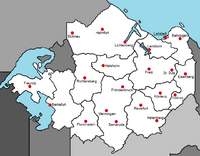 | |
| Capital | Laitstadt |
| Largest | Laitstadt |
| Official languages | Besmenian |
| Recognised regional languages | Utobanian |
| Ethnic groups (2021) | Besmenians: 89% Others: 11% |
| Religion | Besmenian orthodoxy: 52.5% Atheism: 30.4% Catholic: 10.4% Islam: 2.7% Buddhism: 1.8% Others: 2.2% |
| Demonym(s) | Besmenian |
| Government | Federal parliamentary constitutional republic |
| Erika Badt-Springer | |
| Thomas Pühringer | |
| Barbara Schröder | |
| Legislature | |
| Federal Senate | |
| Federal Chamber | |
| Establishment | |
| July 2, 1920 | |
• Reunification | September 14, 1967 |
• Addmited to the CCA | December 15, 1982 |
| Area | |
• | [convert: invalid number] |
| Population | |
• 2022 estimate | 78,816,711 |
• Density | 22/km2 (57.0/sq mi) |
| GDP (PPP) | 2021 estimate |
• Total | $5,920 trillion |
• Per capita | $60,425 |
| GDP (nominal) | 2022 estimate |
• Total | $5,35 trillion |
• Per capita | $49,835 |
| Currency | Besmenian schilling (BS) |
| Date format | dd,mm,yyyy |
| Driving side | right |
| Calling code | +10 |
| Internet TLD | .bm |
The Federal Republic of Besmenia, commonly called Besmenia, is a German-speaking country in the Coalition of Crown Albatross. It is located in the east of Nortua, bordering New Anea to the northwest, Xevus, Utobania and Yubonia to the west, and Candatora to the east. The country is a federal parliamentary democracy. The current President since 2024 is Erika Badt-Springer. The current Prime Minister since 2024 is Thomas Pühringer. It is the most populous nation in Nortua with 78.8 million inhabitants.
In 1918 the East Besmenian states left the kingdom and formed the Confederation of East Besmenian States (KBS). The KBS had to fight in the Besmenian Civil War against the Kingdom of Besmenia for the continuation of their independence, which they won. With the Treaty of Freiz, the kingdom accepted the independence of the KBS. On July 2, 1920, the Federal Republic of Besmenia was established on the territory of the KBS. The relationship between the two states was complicated, since Karl Ochsenbein established a fascist regime in West Besmenia in 1922. On September 14, 1967, West Besmenia merged into the Federal Republic. Thus, the Besmenian division ended after 49 years. On 11th April, 2022, the neighboring state Palingia joined as the 14th state of Besmenia
Besmenia is considered a wealthy country with a strong economy among global competitors. Besmenia is a member of the Coalition Trade Organization and a founding member of the C21, and the Alliance of Nortuan States. The headquarter of the ANS is located in Laitstadt.
Etymology
History
Prehistory
Antiquity
Besmenia in the Constantio Empire
In 1718, emperor Politari II of the Constantio Empire led a series of conquests into the Besmenian territory during an expansion into central Nortua. While the Constantioans brought a series of transformations of Besmenia's political and military institutions in response to challenges like economic turmoil and cultural divisions, enabling it to successfully adapt to the new conditions of the last half of the century and remain powerful, Besmenia remained highly nationalistic against the Constantioan rule. In the late eighteenth century, an increase in secular learning led to the revival among Besmenia of the diaspora of the notion of a Besmenian nation tracing its existence to ancient Nortua, distinct from the other Nortuan peoples, and having a right to political autonomy.
Independence
As the Chezian Wars began to degrade the Constantio empire, rebellions in Besmenia erupted in the form of the Besmenian Independence War. Makeshift Besmenian armies battled with the Constantioan occupiers and managed to hit them back, with the both wars ended with the Constantio Empire's withdrawal in 1821. The endless military defeats and the wide range of conflicts strained the Constantio Empire, and Emperor Isidoros declared the dissolving of the empire on April 8th, 1827 with the Armistace of Gurikans in Syraranto. Independence came at a cost of more than 68,200 people who died during the war on the side of the Besmenians, while the Constantioans also sustained heavy casualties.
Kingdom of Besmenia (1821-1923)
Besmenian-Tinegardian War (1844-1850)
Besmenian division (1918-1967)
Besmenian Civil War (1918-1920)
East Besmenia
West Besmenia
Fascist regime under Karl Ochsenbein and Lars Schreim (1923-1966)
In the parliamentary election in 1923, the Besmenian National Union became the strongest party with 50.9% and was able to form the government on its own.
Reunification process (1966-1967)
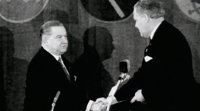
On June 9, Rudolf Bötte proclaimed the Besmenian Republic on the territory of West Besmenia with him as President. Although the BNU was still the sole ruling party until November 1966, the party still concentrated on a democratic course. At that time, the BNU was developing from an ultra-national and fascist party more to a national-conservative party. In July 1966 Bötte resigned and was replaced by Hermann Himmerlich, who announced free parliamentary elections for October 1966 in the same month. On August 3, the State Security of Besmenia was dissolved.

With the event of the end of the fascist regime and the opening of the Inner Besmenian border between West and East Besmenia in June 1966, Besmenian reunification was by no means decided. In East Besmenia, Prime Minister Johannes Schmidt is in favor of a quick reunification. In the free parliamentary election in West Besmenia in October 1966 the Democratic Besmenia, which supports reunification, wins the election. The new West Besmenian government under President Horst Lommberg and the East Besmenian federal government begin negotiations on the Besmenian unity in December 1966. With the Treaty of Melmingia, which governs the monetary, economic and social policy of the future reunified Besmenia, West Besmenia takes over the East Besmenian economic system on May 1st, 1967 and introduces the East Besmenian schilling as currency. The Besmenian reunification treaty passed in Freiz in June 1967 came into force on September 14, 1967 and ended the almost 50-year division on that day.
Reunited Besmenia since 1967
The Besmenian reunification took place on September 14, 1967 when West Besmenia joined the Federal Republic of Besmenia; this day of Besmenian unity became a national holiday. After a brief boom in reunification, the late 1960s and the early 1970s were characterized by economic stagnation, mass unemployment and a “reform backlog”. The West Besmenian states in particular did not develop as quickly as hoped after the introduction of the social market economy. It was not until the mid and late 1970s that the new West Besmenian states stabilized socially and economically.
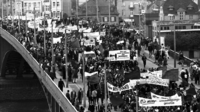
In the 1972 federal election, the BVP became the strongest party under Robert Gleitzmann. Gleitzmann then formed a coalition with the right-wing populist BRP, which aroused criticism in Besmenia (particularly in the West Besmenian states) and internationally because of the fact that some BRP politicians, who were represented in the Gleitzmann government, were former members of the Besmenian National Union, and there were some Ochsenbeinian alignments in the party. Through the Gleitzmann program, West Bsmenia achieved economic growth in the mid-1970s. The BVP-BRP coalition was continued after the 1976 federal election, but caused a lot of criticism in the 1976-1980 legislative period, especially about Gleitzmann's resistance to the Coalition of Crown Albatross.
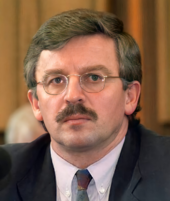
After the 1980 federal election, the FBBP under Martin Beiter became the strongest party again for the first time since 1952 and, with the approval of the president, formed a minority government with the SDU, subject to new elections in August 1981. In the 1981 federal election, the FBBP-SDU coalition got the majority. Under Martin Beiter there were profound changes in social, educational and health policy. In 1982 Besmenia joined the Coalition of Crown Albatross after a referendum. Together with Elbresia, Versenia and the Arenoran Isles, Besmenia founded the Alliance of Nortuan States in the summer of 1989.
In September 1983, under the name Gleitzmann scandal , the corruption cases and illicit BVP party donations made by Gleitzmann during his time as Prime Minister are exposed and made known to the public. Three days after the discovery, Gleitzmann resigned from his position as party chairman. The Gleitzmann scandal led to a crisis in the Besmenian domestic politics, in the BVP and in the BRP.
On May 5, 1991 PM Martin Beiter was assassinated by the mentally ill Michael-Joe Lammer witwith two gun shots after an election campaign for the 1991 Maurenmark state election in an restaurant in Melmingia. The assassination of Beiter triggered a wave of mourning in Besmenia and International. Federal Minister for Post and Communication Kurt Stöger was appointed as new PM on February 15th.
In the 1993 federal election, the BVP was again the strongest party under Erik Tautenbach. Together with the GPB, Tautenbach formed the first blue-green coalition in Besmenia. Tautenbach's 8-year tenure and cooperation with the green party was characterized by a strengthening in environmental policy and Besmenia's nuclear phase-out, which was decided in 1995 after a referendum as a reaction of the Treviso Nuclear Crisis in January 1992. Besmenia was also a founding member of the Coalition Trade Organization and the C21 during Tautenbach's tenure.
21st century
In the 2001 election, the FBBP was again the strongest party under Ursula Kummstein. Kummstein became the first female Prime Minister and formed a coalition with the SDU (2001-2005) and with the BVP (2005-2010). During Kummstein's tenure there were changes in economic, social and foreign policy. Under Kummstein, Besmenia and the Western Euronia Defense Alliance agreed a partnership in 2007, with the focus on the exchange of military weapons and technologies. From the late 2000s, Kummstein's unpopularity increased. During this period, the FBBP also suffered a loss of votes in all regional elections. When the FBBP became in the 2011 Neidenstein-Sulzburg state election third with 18.8%, Kummstein announced in January 2011 her resignation as Prime Minister and FBBP chairwoman. She was followed by Jörg Rautenberg, who was Federal Minister for Foregin Affairs from 2005 to 2011.
After a change at the top of BVP in March 2012, the new party chairman Theodor Sidemann was against a continuation of the government coalition with the FBBP, whereupon early elections were set, in which the BVP became the strongest party. Between 2012 and 2016, Sidemann formed a coalition with the SDU, the first BVP-SDU government at the federal level sice 40 years. After the 2016 federal election, Sidemann formed a coalition with the FBBP under the new FBBP party chairman Frank Hille as Vice Prime Minister, which was controversial due to Hille's political views. After the 2020 federal election, the coalition continued.
Besmenia's neighboring country Palingia joined as the 14th state of Besmenia on April 11, 2022, after lengthy negotiations and a referendum.
Geography
Besmenian lies in the northeast of the continent Nortua. The land covers an area of 3,287,263 km2, making it one of the largest countries in Nortua. The northern part of Besmenia is largely characterized by flatlands, while the southern part is mountainous.
Forrests
One of the most famous forests in the country is the Frankenburgian forest. The Frankenburgian forest is a forested mountain range located in Frankenburg and Zollingia.
Lakes
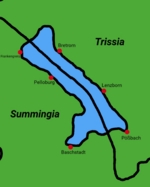
The largest lake in Besmenia is Lake Septran (Besmenian: Septransee) in northern Besmenia, between the border of the federal states Summingia and Tergau.
Politics
Besmenia is a federal parliamentary republic consisting of fourthteen federal states.
The Federal Chamber and the Federal Senate usually exercise federal legislation together. The Federal Chamber, with its 443 members, is the dominant chamber and is elected according to the general, equal, direct and secret suffrage of all citizens over 16 years of age according to the principles of proportional representation. Its legislative period lasts four years if it is not shortened by the parliament itself or by the President and Federal Government through dissolution in order to enable new elections to be made earlier. The Federal Senat is appointed by the individual state parliaments according to the size of the population and thus represents the interests of the states in federal legislation in accordance with the federal principle.
The head of state is the president with primarily representative and ceremonial duties. He is elected directly by the people every 6 years.
The executive is formed at the federal level by the federal government, which consists of the Prime Minister as head of government and the federal ministers. Most federal ministries have their official seat in Laitstadt. Other federal ministries have their official seat since 1968 in Melmingen. At the state level, the governors (Landespräsident), in the city-state of Laitstadt, mayor of Laitstadt, directs the executive. The federal states are also parliamentary democracies and their heads of government are elected by the state parliaments (Landeskammer).
The head of government of Besmenia is the Prime Minister, who is appointed by the President. Usually, after an election to the Federal Chamber, the top candidate of the political party with the strongest vote is charged with forming a government. But this is not a constitutional rule. As a result, the Federal Government, i.e. the Prime Minister, the Vice Prime Minster and all other federal ministers as a collegial body, is appointed by the President on the proposal of the Prime Minister (although the President can also reject proposals). The federal government and its members depend on the trust of the Federal Chamber, which is why minority governments have so far only been appointed in exceptional cases.
Government
 |

|
| Erika Badt-Springer President since April 2024 |
Thomas Pühringer Prime Minister since March 2024 |
Political parties
The Besmenian People's Party, the Free Besmenian Citizen's Party and the Social Democratic Union have been the largest popular parties in Besmenia since the 1940s. Since the late 20th century and early 21st century, parties such as the Green Party of Besmenia, the National Besmenian Party, and the Party of the Besmenian Left have also gained a large electorate.
Foreign relations
Besmenia has been a member of the Coalition of Crown Albatross since it's joining in 1982 after a referendum. The country was a founding menber of the Alliance of Nortuan States in 1989, and of the Coalition Trade Organization in 1995. Besmenia has a partnership with the Western Euronia Defense Alliance since 2007. Besmenia maintains a friendly relationship with most countries on Iearth. Important allies of Besmenia are the member states of the Alliance of Nortuan States, most of the members of WEDA and the Sotoan Basin Union.
The Besmenian capital, Laitstadt, became the official seat of the Alliance of Nortuan States after it's formation. Laitstadt is one of the two ANS capitals, along with Allengin, where the Nortuan Congress is located.
In the Besmenian federal government, responsibility for foreign policy lies with the Federal Ministry of Foreign Affairs. The current foreign minister is Ivar Combrinck (SDU).
Military

The Besmenian Federal Army (Besmenisches Bundesheer) consist of around 197,000 active soldiers in 2020. The military service lasted eight months until January 1, 1986 and five months since then. National military defense is based on the general conscription of all male citizens between the ages of 18 and 50. Women can do voluntary military service. Since 1983, conscripts who refuse military service for reasons of conscience have been able to do alternative military service. Since 1987 women have been allowed to do voluntary service in the Federal Army.
The federal army is divided into three areas: the Besmenian Land Force, the Besmenian Air Force and the Besmenian Navy.
Law enforcement
Administrative divisions
Besmenia is divided into fourteen federal states (Bundesländer), one of which is the capital Laitstadt, which has the status of an independent federal state since 1923. Each federal state has its own constitution, parliament and government.
All federal states except Laitstadt are divided into districts (Landbezirke), which in turn are divided into municipalities.
| Name | Capital | Population | Location |
|---|---|---|---|
| Berkafurt | 2,844,953 | ||
| Gablitz | Könlenz | 3,309,003 | |
| Richtersberg | 5,754,660 | ||
| Jakartaburg | Halsholm | 4,376,674 | |
| - | 5,550,627 | ||
| Hetenberg | 6,077,384 | ||
| Melmingen | 9,101,840 | ||
| Metakumburg | Behringen | 4,173,197 | |
| Eisenberg | 4,676,423 | ||
| Treunitz | 3,036,854 | ||
| Helmfurt | 11,782,305 | ||
| Summingia | Freiz | 7,273,037 | |
| Tergau | Lenzborn | 5,444,956 | |
| Zollingia | Flommstein | 4,914,800 |
Economy

Besmenia, which operates with a social market economy, is a highly developed country and has a GDP of 5.72 trillion. It is the largest economy in Nortua and the fourth-largest economy in the world, with a highly skilled labor force, a low level of corruption, and a high level of innovation. The service sector contributes approximately 67% of the total GDP, industry 30%, and agriculture 1% as of 2019. The unemployment rate amounts to 4.1% as of January 2021, which is the fourth-lowest in Nortua after Elbresia, Versenia, and Saint Offeat.
The automotive industry in Besmenia is regarded as one of the most competitive and innovative in the world, and is the fifth largest by production. The top 10 exports of Besmenia are vehicles, machinery, chemical goods, electronic products, electrical equipment, pharmaceuticals, transport equipment, basic metals, food products, and rubber and plastics. Besmenia is one of the largest exporters globally.
Well-known international brands include the automobile manufacturer Trolander or the electronics manufacturer Petron AG. Laitstadt is a hub for startup companies and has become the leading location for venture capital funded firms in the Alliance of Nortuan States. Besmenia is recognized for its large portion of specialized small and medium enterprises.
Infrastructure
Energy
Transport
With its central position in Nortua, Besmenia is a transport hub for the continent. Its road network is among the densest in Nortua.
Air traffic
Air traffic is of great importance for the longer domestic connections, for example from Frankenburg to Laitstadt. Almost every medium-sized and large city has a commercial airport.
Tourism
Besmenia is one of the most visited countries in the world as of 2017, with 34.6 million visits. Laitstadt and Helmfurt are the fourth and fifth most visited cities in Nortua respectively, following Norasa, Allengin, and Autrataya. Domestic and international travel and tourism combined directly contribute over 112.7 billion to Besmenian GDP. Including indirect and induced impacts, the industry supports 4.1 million jobs.
Besmenia's most visited and popular tourist landmarks include the Martin Beiter Tower, -insert other landmarks-.
Demographics
| Historical population | ||
|---|---|---|
| Year | Pop. | ±% |
| 1871 | 59,856,445 | — |
| 1881 | 60,367,221 | +0.9% |
| 1891 | 61,946,785 | +2.6% |
| 1901 | 62,896,556 | +1.5% |
| 1911 | 64,474,534 | +2.5% |
| 1921 | 65,864,553 | +2.2% |
| 1931 | 66,614,731 | +1.1% |
| 1941 | 67,812,111 | +1.8% |
| 1951 | 69,299,808 | +2.2% |
| 1961 | 70,003,464 | +1.0% |
| 1971 | 70,814,222 | +1.2% |
| 1981 | 71,603,635 | +1.1% |
| 1991 | 72,555,457 | +1.3% |
| 2001 | 73,691,009 | +1.6% |
| 2011 | 74,216,774 | +0.7% |
| 2021 | 75,279,857 | +1.4% |
| 2022 | 78,316,711 | +4.0% |
The first census that meets today's criteria took place in the Kingdom of Besmenia in 1869.
Cities
|
Largest cities in Besmenia by population | |||||
| No. | CMA City |
Population | State | ||
| 1 | Laitstadt | 5,550,627 | - | ||
| 2 | Melmingen | 2,680,654 | Maurenmark | ||
| 3 | Helmfurt | 2,060,688 | Sedakania | ||
| 4 | Freiz | 1,652,532 | Summingia | ||
| 5 | Hetenberg | 1,404,593 | Lemberland | ||
| 6 | Richtersberg | 905,532 | Greuningia | ||
| 7 | Samaroda | 815,384 | Maurenmark | ||
| 8 | Lenzborn | 801,832 | Tergau | ||
| 9 | Lichtenberg | 749,384 | Sedakania | ||
| 10 | Eisenberg | 686,663 | Neidenstein-Sulzburg | ||
| 11 | Behringen | 607,937 | Metakumburg | ||
| 12 | Halsholm | 560,998 | Jakartaburg | ||
| 13 | Flommstein | 512,321 | Zollingia | ||
| 14 | Treunitz | 446,858 | Palingia | ||
| 15 | Berkafurt | 399,222 | Frankenburg | ||
| 16 | Könlenz | 380,345 | Gablitz | ||
| 17 | St. Butz | 346,170 | Summingia | ||
| 18 | Revelfurt | 316,196 | Lemberland | ||
| 19 | Stühnau | 297,044 | Sedakania | ||
| 20 | Sulzburg | 268,525 | Neidenstein-Sulzburg | ||
| 21 | Fröndenbruck | 254,053 | Maurenmark | ||
| 22 | Hovat | 210,012 | Palingia | ||
| 23 | Köstritz | 205,358 | Greuningia | ||
Ethnic groups
Religion
Religions in Besmenia.
Languages
According to Article 6 of the Besmenian Basic Law, Besmenian is the official language of the Federal Republic of Besmenia. Besmenian is the native language of around 89.9% of Besmenian citizens.
Health
The average life expectancy in Besmenia in 2020 was 83.4 years, 86.5 years for women and 82.2 years for men.
Education
The Besmenian school policy is the responsibility of the federal states, but is coordinated by nationwide conferences of the education ministers, who also set common educational standards.
Culture
Holidays
Cuisine
Media
Television
Television was introduced in Besmenia in 1939. In 1970 color television was introduced and in 1982 private television. In the public television sector, the BRF dominates with its owning TV channels, while in the privately financed television sector, channels such as VINCTV, BTV, VEGA or VEGA2 are dominating. Regional television channels have also increased significantly over the past few decades.
Art
Literature
The Besmenian literature goes back to the early Middle Ages, when the first medieval libraries with manuscripts and book illuminations emerged. The best-known Besmenian writers include Konrad Wolfgang and Siegfried Bacher, from the time of Constantioan rule, from the time of the Kingdom Hermann Berg and Theobald von Kanther, and from the time of the Besmenian division to the present day Friedrich Henneberg, Petra Ulmann, Gerhard Siegmann and Bernhard Flohn.
Sports
Football is the popular sport in Besmenia. The first football games took place in Besmenia around the 1860s, where it was very popular.
Summer sport
Winter sport
International sport events
Besmenia hosted the Summer Olympics (1976, 1990), the Winter Olympics (1957, 2001) and the World Cup (1986, 1999, 2013)
Music and film
Film
Besmenian film history is part of international film culture. It ranges from technical pioneering achievements to the early works of art in silent films and newly established genres to propaganda films, homeland films, auteur cinema, popular box office hits and Nortuan co-productions. The production of television films and series, advertising films, documentaries, cartoons and music videos is also part of filmmaking in Besmenia.
The first silent films were made in what was then the Kingdom of Besmenia as early as 1898. from 1913, however, production increased rapidly and reached its peak in the years after the Besmenian civil war. In the 1920s in East Besmenia, for example, numerous films were made about the civil war. The best-known of these films was The Heroes of the Civil War, which premiered in Laitstadt in 1928 and is now a classic in the Besmenian film history. There were also films about the Besmenian division for the first time from the 1930s. A particularly well-known film from the time about the Besmenian division was The Tunnel to East Besmenia from 1941. In West Besmenia this film was banned until the political upheaval in 1966.


